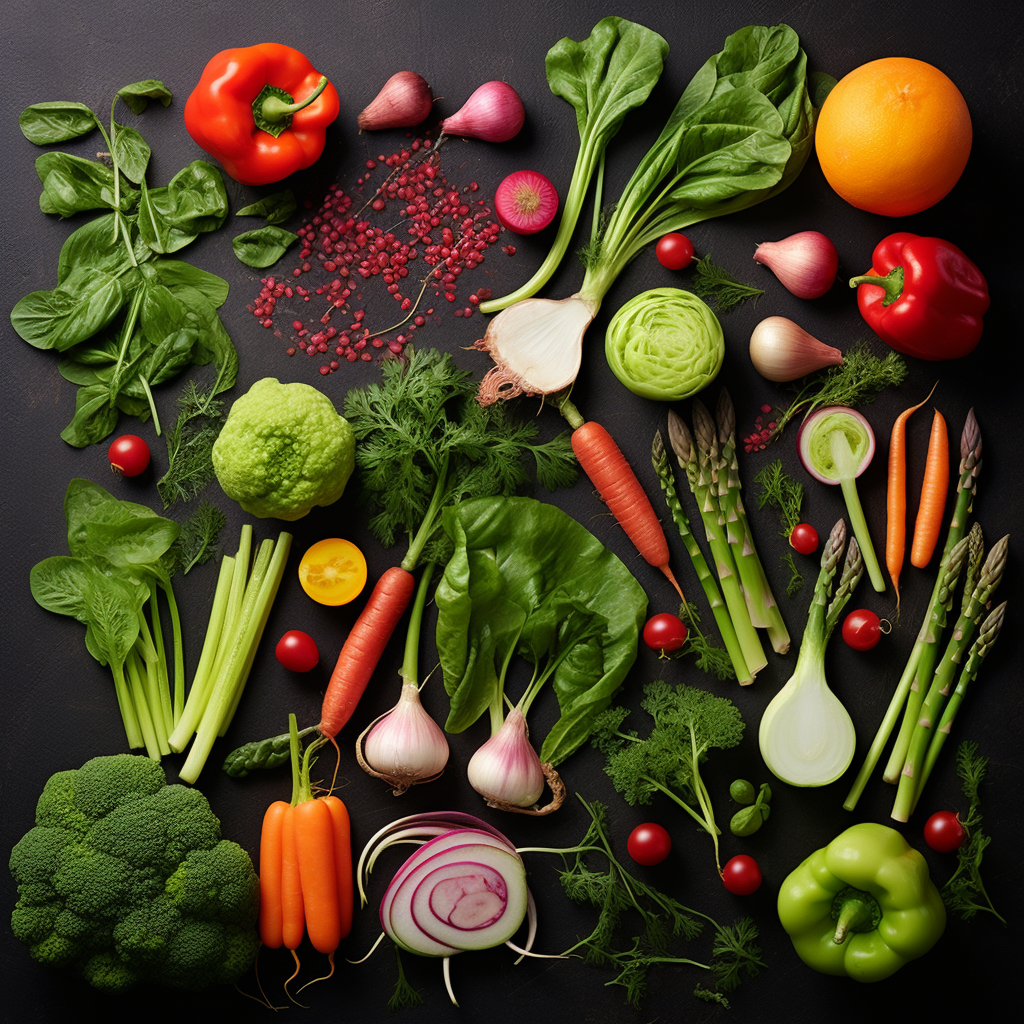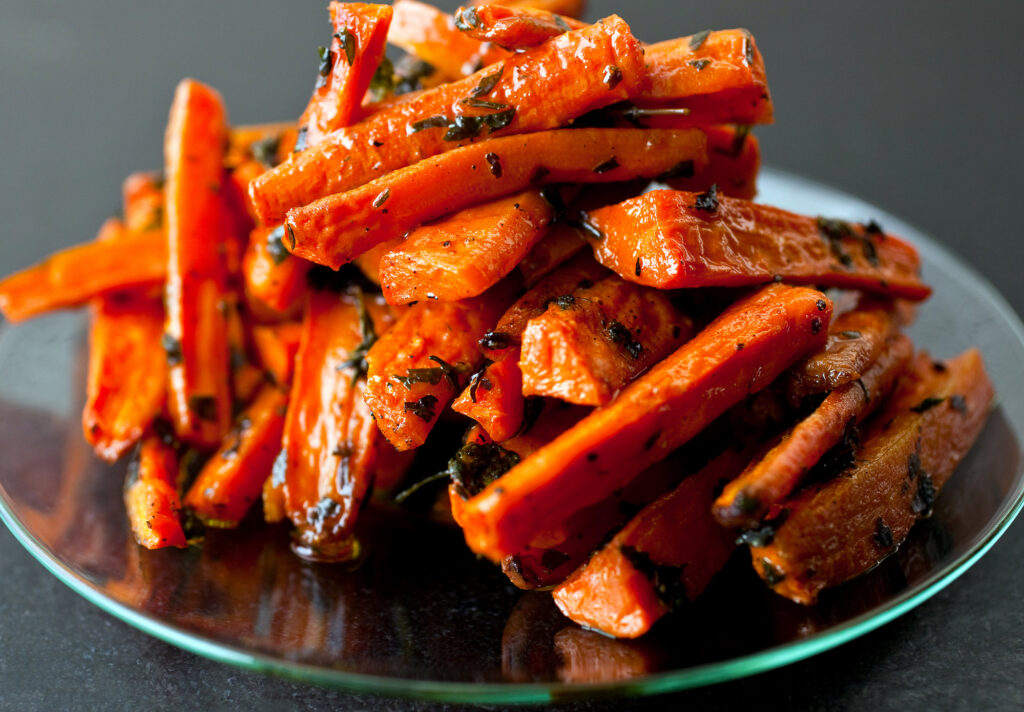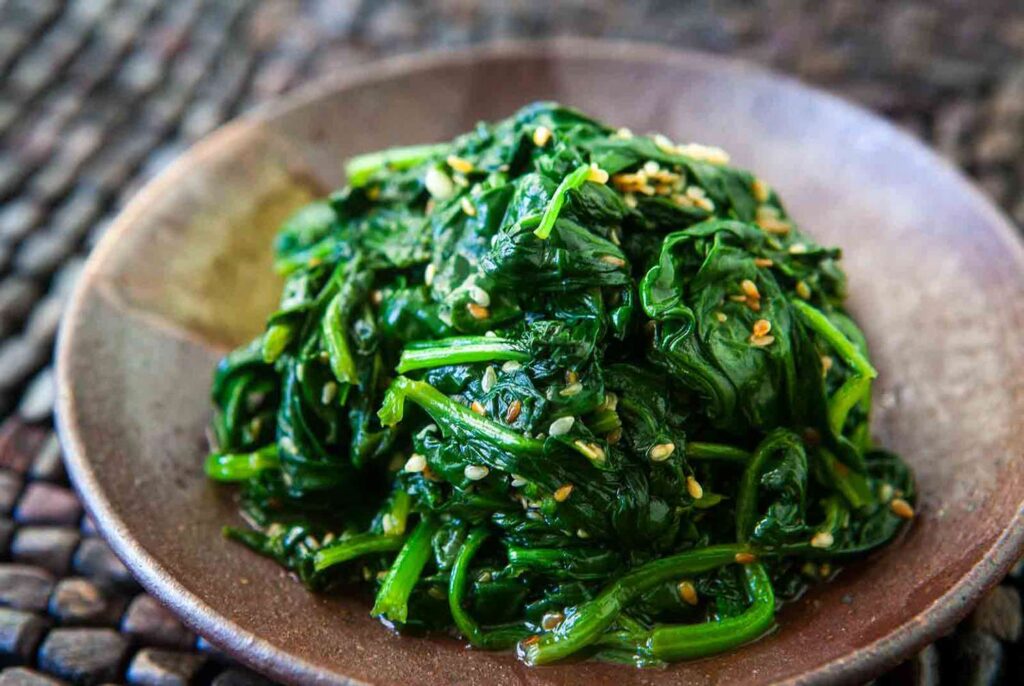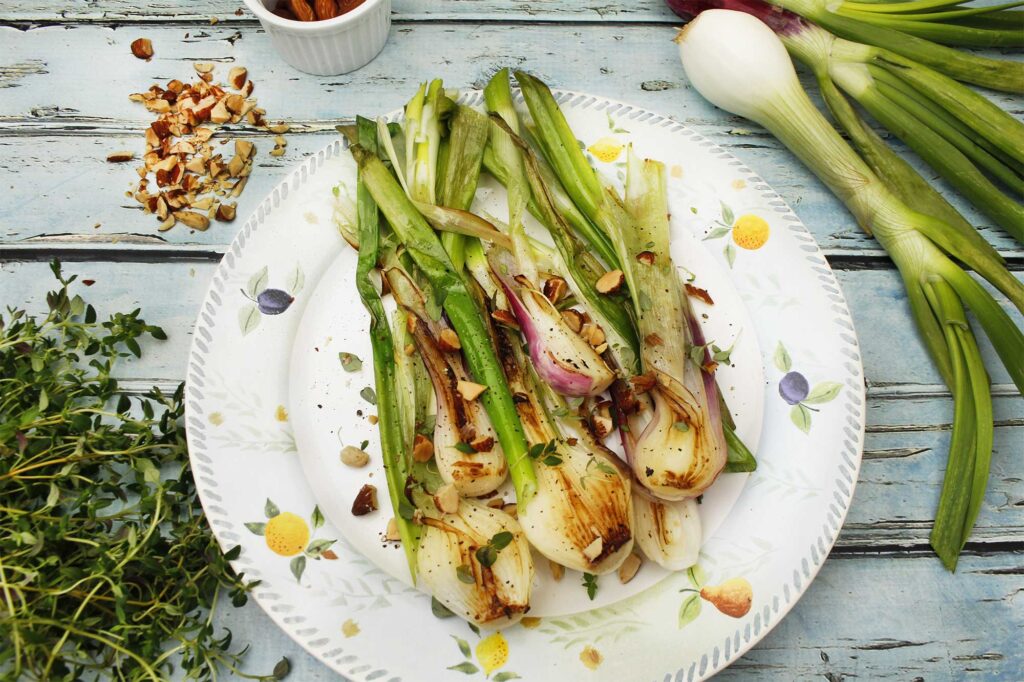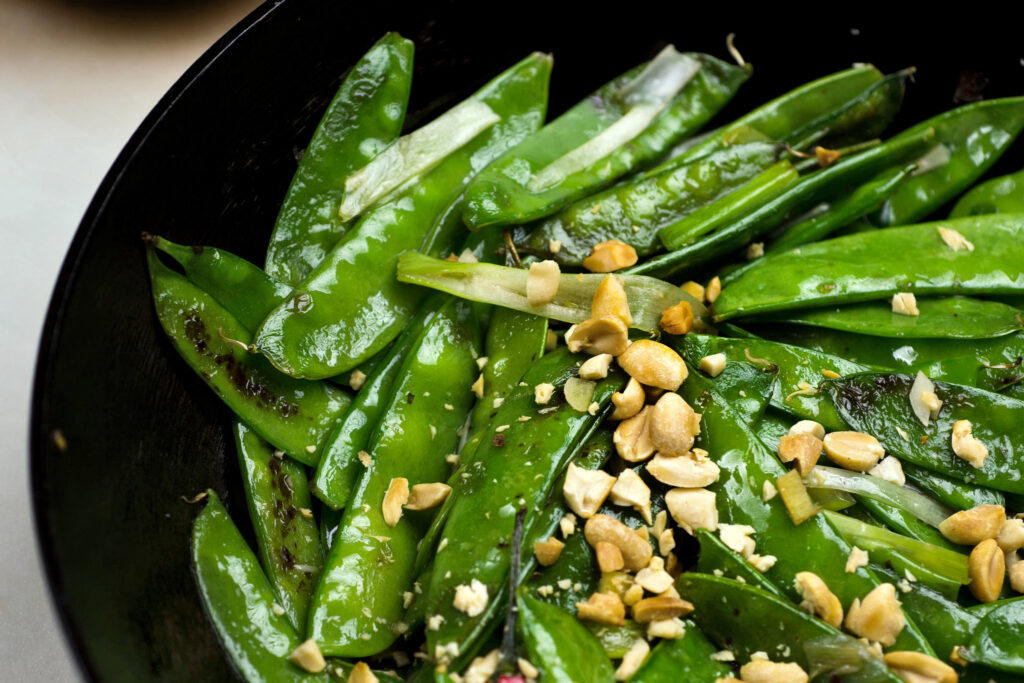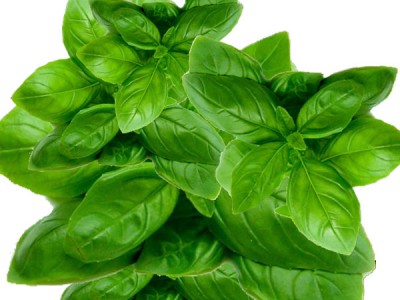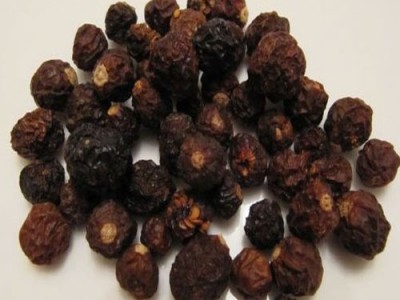
10 Best Vegetables For Spring Season
Carrot Vegetable
1)Carrot Vegetable For Spring Season:
Scientific Name – Daucus Carota
Carrot, scientifically known as Daucus carota, is a vibrant and nutritious root vegetable that has been cultivated and cherished for thousands of years. With its sweet and crunchy texture, carrots have become a favorite ingredient in various cuisines around the world, as well as a popular choice for snacking and juicing.
Originating in Central Asia, carrots have a rich history that dates back to ancient civilizations like the Greeks, Romans, and Persians. Over the centuries, they have traveled across continents and evolved into the familiar orange variety we know today, although carrots also come in a range of colors, including purple, red, yellow, and white.
One of the distinctive features of carrots is their bright orange color, which is due to the presence of beta-carotene, a precursor of vitamin A. This essential nutrient gives carrots their reputation for promoting good vision and overall eye health.
Carrots are renowned for their versatility in the kitchen. They can be enjoyed raw as a healthy and satisfying snack, sliced into salads for a burst of color and flavor, or used as a key ingredient in soups, stews, and stir-fries. Additionally, they are widely used in baking and juicing, contributing natural sweetness and moisture to cakes, muffins, and fresh beverages.
In addition to their delicious taste, carrots offer a wealth of nutritional benefits. They are an excellent source of vitamins and minerals, including vitamin K, vitamin C, potassium, and fiber. Regular consumption of carrots is associated with various health benefits, including improved heart health, enhanced digestion, and bolstered immunity.
Carrots are relatively easy to cultivate, making them a popular choice for home gardeners interested in growing their produce. They can be grown in various climates and soil types, making them accessible to people around the globe.
Beyond their culinary and nutritional virtues, carrots have also found their way into folklore and culture, symbolizing fertility, good luck, and prosperity in various traditions.
In this article, we will explore the delightful world of carrots, from their historical journey across civilizations to their modern-day culinary and nutritional significance. We will savor delicious carrot-inspired recipes and uncover the health benefits that make carrots a cherished addition to a balanced diet. So, let’s embark on a journey to celebrate the vibrant and nourishing charm of carrots, a vegetable that continues to bring joy and well-being to tables and lives worldwide.
Health Benefits Of Carrot Vegetable:
- Nutritional Value: Carrots are packed with essential nutrients. They are an excellent source of beta-carotene, vitamin A, vitamin K, and dietary fiber. These nutrients support immune function, promote healthy vision, aid in digestion, and contribute to overall well-being.
- Antioxidant Power: Carrots are rich in antioxidants, including beta-carotene, which gives them their vibrant orange color. Antioxidants help protect the body’s cells from oxidative damage caused by harmful free radicals. Regular consumption of carrots may help reduce the risk of chronic diseases and support overall health.
- Promote Healthy Skin: The antioxidants and vitamins in carrots contribute to healthy skin. Beta-carotene is converted to vitamin A in the body, which is essential for maintaining skin health. Carrots help protect the skin from sun damage, improve skin tone, and promote a youthful appearance.
- Eye Health: Carrots are well-known for their beneficial effects on vision. They are rich in beta-carotene, which is converted to vitamin A in the body. Vitamin A is necessary for good vision and eye health, helping to maintain night vision and reducing the risk of age-related macular degeneration.
- Digestive Health: Carrots are a good source of dietary fiber, which supports a healthy digestive system. Fiber adds bulk to the stool, promotes regular bowel movements, and helps prevent constipation. It also nourishes beneficial gut bacteria, supporting a healthy gut microbiome.
- Hydration: Carrots have a high water content, contributing to hydration during the spring season. Staying hydrated is important for maintaining bodily functions and overall well-being.
- Weight Management: Carrots are low in calories and high in fiber, making them a great addition to a weight management or weight loss diet. The fiber content helps promote feelings of fullness and satiety, reducing the likelihood of overeating.
- Seasonal Availability: Spring is a prime time for fresh, locally grown carrots. Consuming seasonal produce often ensures better flavor, higher nutrient content, and support for local agriculture.
Carrot Used For Home:
- Raw Snacks: Carrots can be peeled and sliced into sticks, making them a healthy and crunchy snack option, especially when served with dips like hummus or ranch dressing.
- Salads: Shredded or thinly sliced carrots are often added to salads for color, texture, and a touch of sweetness. Carrot salads can be enjoyed on their own or as part of mixed green salads.
- Stir-fries and Noodles: Carrots are frequently used in stir-fry dishes and noodle recipes, adding color, nutrition, and a slightly sweet taste to the overall dish.
- Soups and Stews: Carrots are a common ingredient in various soups and stews, such as chicken noodle soup and beef stew, contributing both flavor and substance to the broth.
- Roasted Carrots: Roasting carrots in the oven with olive oil, salt, and herbs brings out their natural sweetness and creates a delicious side dish.
- Mashed Carrots: Cooked and mashed carrots can be a tasty and nutritious alternative to mashed potatoes.
- Carrot Cake: Carrots are a key ingredient in the beloved dessert, carrot cake, providing moisture and sweetness.
- Vegetable Juices: Carrots are often juiced with other vegetables and fruits to create refreshing and nutritious drinks.
- Carrot Puree: Cooked and pureed carrots can be used as a baby food or as a base for soups and sauces.
- Pickled Carrots: Carrots can be pickled with vinegar and spices, creating a tangy and crunchy pickle that can be enjoyed as a snack or a condiment.
Spinach Vegetable
2)Spinach Vegetable For Spring Season:
Scientific Name –Spinacia Oleracea
Spinach, scientifically known as Spinacia oleracea, is a leafy green vegetable celebrated for its tender leaves, mild flavor, and remarkable nutritional value. Believed to have originated in ancient Persia (modern-day Iran), spinach has a storied history that spans thousands of years, making it one of the oldest cultivated vegetables in the world.
This nutrient-packed leafy green earned its reputation as a powerhouse vegetable due to its impressive array of vitamins, minerals, and antioxidants. Spinach is an excellent source of vitamins A, C, and K, as well as folate, iron, calcium, and magnesium. It is a valuable addition to a balanced diet and offers numerous health benefits, including supporting bone health, improving vision, and promoting a healthy heart.
In the culinary world, spinach’s versatility makes it a cherished ingredient across various cuisines. It can be enjoyed raw in salads, where its tender leaves add a delightful crunch and freshness. When cooked, spinach can be sautéed, steamed, or added to soups, stews, and casseroles, contributing a rich and earthy taste to these dishes.
Popeye, the iconic cartoon character, famously brought spinach into the limelight, emphasizing its role in promoting strength and energy. While spinach may not instantly turn us into superhumans, it indeed provides an abundance of essential nutrients to support overall health and well-being.
Cultivating spinach is relatively straightforward, and it can be grown in various climates, both in outdoor gardens and indoor containers. Its adaptability and fast growth rate make it a popular choice for home gardeners seeking to grow their greens.
Beyond its culinary and nutritional merits, spinach has also found its place in cultural traditions and literary references. It is often associated with vitality and renewal, symbolizing growth and rejuvenation in various contexts.
In this article, we will explore the wonderful world of spinach, from its ancient origins to its modern-day popularity as a nutritional powerhouse. We will savor delicious spinach-inspired recipes and uncover the numerous health benefits that make spinach a valuable addition to any diet. So, let’s embrace the leafy green charm of spinach, a vegetable that continues to nourish and delight palates worldwide.
Health Benefits Of Spinach Vegetable:
- Nutritional Value: Spinach is a nutrient-dense leafy green vegetable. It is rich in vitamins A, C, and K, as well as folate, iron, and other essential minerals. These nutrients support immune function, promote healthy bones, aid in blood clotting, and contribute to overall well-being.
- Antioxidant Power: Spinach is packed with antioxidants, including vitamin C, vitamin E, and various phytochemicals. Antioxidants help protect the body’s cells from oxidative damage caused by harmful free radicals. Regular consumption of spinach may help reduce the risk of chronic diseases and support overall health.
- Eye Health: Spinach contains lutein and zeaxanthin, two antioxidants that are beneficial for eye health. These compounds are concentrated in the retina and help protect against age-related macular degeneration and cataracts.
- Bone Health: Spinach is a good source of vitamin K, which plays a crucial role in maintaining healthy bones. Vitamin K helps regulate calcium balance in the body and contributes to bone mineralization, which is important for maintaining strong and healthy bones.
- Digestive Health: Spinach is rich in dietary fiber, which supports a healthy digestive system. Fiber adds bulk to the stool, promotes regular bowel movements, and helps prevent constipation. It also nourishes beneficial gut bacteria, supporting a healthy gut microbiome.
- Hydration: Spinach has a high water content, contributing to hydration during the spring season. Staying properly hydrated is important for maintaining bodily functions and overall well-being.
- Weight Management: Spinach is low in calories and high in fiber, making it an excellent choice for weight management or weight loss. The fiber content helps promote feelings of fullness and satiety, reducing the likelihood of overeating.
- Seasonal Availability: Spring is a prime time for fresh, locally grown spinach. Consuming seasonal produce often ensures better flavor, higher nutrient content, and support for local agriculture.
Spinach Used For Home:
- Salads: Spinach can be used as a base for fresh salads, providing a nutrient-rich and flavorful alternative to traditional lettuce. It pairs well with various toppings, such as fruits, nuts, cheese, and vinaigrettes.
- Sauteed or Stir-fried: Spinach can be quickly sautéed or stir-fried with garlic and olive oil, making a delicious and nutritious side dish for a variety of main courses.
- Pasta Dishes: Spinach can be added to pasta dishes, such as lasagna, stuffed pasta shells, and pasta salads, contributing both color and nutrients.
- Smoothies: Spinach is a popular addition to green smoothies, where its mild flavor is easily masked by the sweetness of fruits, making it an excellent way to boost your daily vegetable intake.
- Soups: Spinach can be included in soups, such as minestrone or vegetable soup, adding a burst of green color and valuable nutrients.
- Spinach Dip: Creamed spinach dip is a delicious appetizer, often served with bread, crackers, or fresh vegetables for dipping.
- Quiches and Frittatas: Spinach is a classic ingredient in quiches and frittatas, where it adds both flavor and color to the egg-based dishes.
- Curries and Indian Dishes: Spinach is commonly used in Indian cuisine, where it is known as “palak.” It is used in various curries, such as saag paneer, as well as in lentil and rice dishes.
- Grains and Grain Bowls: Spinach can be incorporated into grain-based dishes like rice, quinoa, or couscous, creating nutritious and satisfying meals.
- Stuffed Spinach: Large spinach leaves can be used as wraps to make stuffed rolls, filled with various ingredients like cheese, rice, or meat.
Radish Vegetable
3)Radish Vegetable For Spring Season:
Scientific Name – Raphanus Sativus
Radish, scientifically known as Raphanus sativus, is a crisp and pungent root vegetable that has been enjoyed for its unique flavor and nutritional benefits for centuries. Believed to have originated in Southeast Asia, radishes have a long history of cultivation and have spread across various continents, becoming a popular ingredient in cuisines around the world.
With its distinctive taste and crunchy texture, the radish adds a refreshing and zesty element to dishes. Radishes come in various shapes, sizes, and colors, ranging from small round red radishes to larger white, black, or multicolored varieties. Each type offers a different taste experience, from mildly sweet to peppery and spicy.
In the culinary realm, radishes are incredibly versatile and can be enjoyed in both raw and cooked forms. When raw, they add a delightful crispness and a peppery kick to salads and sandwiches. Sliced or shredded, they make colorful garnishes for a wide range of dishes. Cooked radishes offer a milder flavor and can be roasted, sautéed, or pickled, bringing out their natural sweetness.
Beyond their culinary appeal, radishes are a nutrient-dense vegetable. They are low in calories and a good source of vitamin C, potassium, and dietary fiber. Additionally, radishes contain various antioxidants that contribute to their potential health benefits.
Cultivating radishes is relatively simple, and they are a popular choice for home gardeners due to their fast growth and adaptability to different climates.
In addition to their culinary and nutritional merits, radishes have also found their place in cultural traditions and folklore. They are often associated with springtime and renewal, symbolizing growth and fertility in various cultural contexts.
In this article, we will explore the delightful world of radishes, from their historical journey across civilizations to their modern-day culinary significance. We will savor delicious radish-inspired recipes and uncover the health benefits that make radishes a valuable addition to a balanced diet. So, let’s embark on a journey to celebrate the crisp and peppery charm of radishes, a vegetable that continues to add zest and vibrancy to our meals and festivities.
Health Benefits Of Radish Vegetable:
- Hydration: Radishes have a high water content, which can help keep you hydrated during the warmer spring months. Staying properly hydrated is important for maintaining bodily functions and preventing dehydration.
- Nutritional Value: Radishes are low in calories and rich in essential nutrients. They are a good source of vitamin C, vitamin K, dietary fiber, and minerals such as potassium and manganese. These nutrients support immune function, promote healthy bones, aid in digestion, and contribute to overall well-being.
- Digestive Health: Radishes are rich in dietary fiber, which supports a healthy digestive system. Fiber adds bulk to the stool, promotes regular bowel movements, and helps prevent constipation. Consuming radishes can contribute to a healthy gut and aid in digestion.
- Antioxidant Power: Radishes contain various antioxidants, including vitamin C, anthocyanins, and flavonoids. Antioxidants help protect the body’s cells from oxidative damage caused by harmful free radicals. Regular consumption of radishes may help reduce the risk of chronic diseases and support overall health.
- Liver Health: Radishes are known for their beneficial effects on liver health. They contain compounds that help detoxify and cleanse the liver, supporting its proper functioning. Consuming radishes can contribute to liver health and overall detoxification.
- Weight Management: Radishes are low in calories and high in fiber, making them a great addition to a weight management or weight loss diet. The fiber content helps promote feelings of fullness and satiety, reducing the likelihood of overeating.
- Seasonal Availability: Radishes are often at their peak during the spring season, making them readily available and fresh. Consuming seasonal produce often ensures better flavor, higher nutrient content, and support for local agriculture.
Radish Used For Home:
- Salads: Radishes are often used in salads for their crunchy texture and peppery flavor. They can be thinly sliced, grated, or even left whole to add a refreshing element to the salad.
- Pickles: Radishes can be pickled with vinegar, salt, and spices, creating tangy and crunchy pickled radishes that can be enjoyed as a condiment or a snack.
- Toppings: Sliced radishes make a colorful and flavorful topping for sandwiches, tacos, and burgers.
- Roasted or Grilled: Radishes can be roasted or grilled, which brings out their natural sweetness and mellows their spiciness.
- Soups and Stews: Radishes can be added to soups and stews, providing a unique taste and texture to the dish.
- Stir-fries: Radishes can be included in stir-fry dishes with other vegetables and proteins, adding a refreshing crunch.
- Dips: Radishes can be used as dippers for hummus, guacamole, or other creamy dips.
- Garnishes: Whole or sliced radishes can be used as garnishes for various dishes, adding a pop of color and flavor.
- Radish Greens: Don’t discard the radish greens! They are edible and can be used in salads or cooked like other leafy greens.
- Radish Slaw: Grated or julienned radishes can be combined with other vegetables to create a fresh and vibrant slaw.
Spring Onion Vegetable
4)Spring Onion Vegetable For Spring Season:
Scientific Name – Allium Fistulosum
Spring onion, also known as green onion, scallion, or Allium fistulosum, is a versatile and flavorful vegetable that belongs to the Allium family. While closely related to onions and garlic, spring onions are distinct in their appearance and taste, offering a milder and more delicate flavor profile.
Spring onions are characterized by their long, slender green stalks and small white bulbs. They are a popular ingredient in various cuisines around the world, celebrated for their versatility and ability to enhance the taste of a wide range of dishes.
Unlike fully matured onions, spring onions are harvested at an earlier stage of growth, before the bulb has fully developed. This gives them their characteristic tender texture and mild taste, making them ideal for raw consumption or quick cooking methods.
In the culinary realm, spring onions can be used in both raw and cooked forms. When used raw, their mild flavor adds a refreshing and onion-like kick to salads, salsas, and sandwiches. Chopped spring onions are often used as a garnish or a final touch to dishes, providing a burst of color and freshness.
In cooking, spring onions can be sautéed, grilled, or used as a key ingredient in stir-fries, soups, and omelets. They pair well with other vegetables, meats, and seafood, adding depth and aroma to the preparation.
Aside from their culinary appeal, spring onions offer nutritional benefits. They are a good source of vitamins A, C, and K, as well as essential minerals such as calcium and iron. Additionally, they contain beneficial sulfur compounds that contribute to their potential health-promoting properties.
Cultivating spring onions is relatively straightforward, and they can be grown in home gardens or in containers on balconies or windowsills, making them accessible to home gardeners interested in growing their produce.
In many cultures, spring onions are associated with the arrival of spring, symbolizing renewal and growth. They have become a treasured ingredient in seasonal dishes and traditional recipes that celebrate the change of seasons.
In this article, we will explore the delightful world of spring onions, from their culinary versatility to their nutritional virtues. We will savor delicious spring onion-inspired recipes and uncover the health benefits that make spring onions a valuable addition to a well-rounded diet. So, let’s embrace the fresh and vibrant charm of spring onions, a vegetable that continues to enrich our culinary experiences and connect us with the joys of the changing seasons.
Health Benefits Of Spring Onion Vegetable:
- Nutritional Value: Spring onions are low in calories and packed with essential nutrients. They are a good source of vitamin C, vitamin K, vitamin A, and dietary fiber. These nutrients support immune function, promote healthy bones, aid in digestion, and contribute to overall well-being.
- Hydration: Spring onions have a high water content, which can help keep you hydrated during the warmer spring months. Staying properly hydrated is important for maintaining bodily functions and preventing dehydration.
- Digestive Health: Spring onions contain dietary fiber, which supports a healthy digestive system. Fiber adds bulk to the stool, promotes regular bowel movements, and helps prevent constipation. Consuming spring onions can contribute to a healthy gut and aid in digestion.
- Antioxidant Power: Spring onions are rich in antioxidants, including vitamin C and flavonoids. Antioxidants help protect the body’s cells from oxidative damage caused by harmful free radicals. Regular consumption of spring onions may help reduce the risk of chronic diseases and support overall health.
- Blood Sugar Regulation: Spring onions have a low glycemic index, meaning they have a minimal impact on blood sugar levels. This makes them suitable for individuals with diabetes or those looking to manage their blood sugar levels. The fiber content in spring onions also helps regulate blood sugar levels.
- Weight Management: Spring onions are low in calories and high in fiber, making them an excellent choice for weight management or weight loss. The fiber content helps promote feelings of fullness and satiety, reducing the likelihood of overeating.
- Seasonal Availability: Spring onions are often at their peak during the spring season, making them readily available and fresh. Consuming seasonal produce often ensures better flavor, higher nutrient content, and support for local agriculture.
Spring Onion Used For Home:
- Salads: Spring onions can be thinly sliced and added to salads, providing a refreshing crunch and mild onion flavor.
- Stir-fries: Spring onions are frequently used in stir-fry dishes, where they add both flavor and color to the overall dish.
- Soups and Noodle Bowls: Spring onions can be used as a garnish for soups, ramen, and noodle bowls, enhancing the presentation and taste.
- Omelettes and Frittatas: Chopped spring onions can be added to omelettes and frittatas for extra flavor and a pop of green color.
- Sauces and Dips: Spring onions can be blended into sauces and dips to provide a mild onion taste.
- Toppings for Asian Dishes: Spring onions are commonly used as a topping for various Asian dishes, such as dumplings, congee, and sushi rolls.
- Grilled or Roasted: Whole spring onions can be grilled or roasted alongside other vegetables or meats, adding a delicious caramelized flavor.
- Marinades: Chopped spring onions can be included in marinades for meats and tofu, infusing them with a subtle onion taste.
- Garnishes: Spring onions can be used as a garnish for a wide range of dishes, adding visual appeal and a burst of flavor.
- Scallion Pancakes: Spring onions are a key ingredient in scallion pancakes, a popular Chinese dish that is both savory and crispy.
Snow Peas Vegetable
5)Snow Peas Vegetable For Spring Season:
Scientific Name – Pisum Sativum Var. Saccharatum
Snow peas, scientifically known as Pisum sativum var. saccharatum, are a delectable and versatile legume that adds a delightful crunch and subtle sweetness to a variety of dishes. Also known as sugar peas or Chinese pea pods, snow peas are a unique type of pea that is harvested while the peas inside are still small and underdeveloped, giving them a tender and edible pod.
Native to Southeast Asia, snow peas have been cultivated and enjoyed for their delightful taste and nutritional benefits for centuries. They have since become a popular ingredient in cuisines around the world, particularly in Asian, Mediterranean, and Western dishes.
Snow peas are easily distinguishable by their flat, thin, and translucent pods. The peas inside are barely discernible and not as starchy as garden peas, which makes them perfect for quick cooking methods.
In the culinary world, snow peas are highly valued for their delicate flavor and crisp texture. They are often used in stir-fries, salads, and noodle dishes, where their vibrant green color and fresh taste complement a variety of ingredients. Snow peas are also a popular addition to vegetable medleys, adding a touch of sweetness and visual appeal.
One of the key advantages of snow peas is their rapid cooking time, making them an ideal choice for retaining their crunch in dishes that require minimal cooking.
Nutritionally, snow peas offer an array of health benefits. They are a good source of vitamins C and K, as well as dietary fiber and important minerals like iron and calcium. With their low calorie content and rich nutrient profile, snow peas are a valuable addition to a balanced and health-conscious diet.
Cultivating snow peas is relatively straightforward, and they can be grown in home gardens or in containers on patios or balconies, making them accessible to home gardeners looking to enjoy their fresh produce.
In many cultures, snow peas are celebrated for their association with springtime and renewal, symbolizing growth and vitality.
In this article, we will explore the delightful world of snow peas, from their historical origins to their modern-day culinary significance. We will savor delicious snow pea-inspired recipes and uncover the health benefits that make snow peas a delightful and nutritious addition to a wide array of dishes. So, let’s embrace the crisp and sweet charm of snow peas, a legume that continues to elevate our culinary experiences and delight our taste buds with its unique attributes.
Health Benefits Of Snow Peas Vegetable:
- Nutritional Value: Snow peas are low in calories and rich in essential nutrients. They are a good source of vitamin C, vitamin K, dietary fiber, and minerals such as potassium and iron. These nutrients support immune function, promote healthy bones, aid in digestion, and contribute to overall well-being.
- Hydration: Snow peas have a high water content, which can help keep you hydrated during the warmer spring months. Staying properly hydrated is important for maintaining bodily functions and preventing dehydration.
- Antioxidant Power: Snow peas are rich in antioxidants, including vitamin C and various phytochemicals. Antioxidants help protect the body’s cells from oxidative damage caused by harmful free radicals. Regular consumption of snow peas may help reduce the risk of chronic diseases and support overall health.
- Digestive Health: Snow peas are a good source of dietary fiber, which supports a healthy digestive system. Fiber adds bulk to the stool, promotes regular bowel movements, and helps prevent constipation. It also nourishes beneficial gut bacteria, supporting a healthy gut microbiome.
- Weight Management: Snow peas are low in calories and high in fiber, making them an excellent choice for weight management or weight loss. The fiber content helps promote feelings of fullness and satiety, reducing the likelihood of overeating.
- Blood Sugar Regulation: Snow peas have a low glycemic index, meaning they have a minimal impact on blood sugar levels. This makes them suitable for individuals with diabetes or those looking to manage their blood sugar levels. The fiber content in snow peas also helps regulate blood sugar levels.
- Seasonal Availability: Snow peas are often at their peak during the spring season, making them readily available and fresh. Consuming seasonal produce often ensures better flavor, higher nutrient content, and support for local agriculture.
Snow Peas Used For Home:
- Stir-fries: Snow peas are frequently used in stir-fry dishes, as their crispness adds a delightful crunch to the overall dish.
- Salads: Snow peas can be included in salads for their refreshing and sweet taste. They are often combined with other vegetables and vinaigrettes.
- Sauteed or Stir-fried: Snow peas can be quickly sauteed or stir-fried with garlic and soy sauce, making a simple and tasty side dish.
- Raw Snacks: Snow peas can be enjoyed as a healthy and crunchy snack on their own or with dips like hummus.
- Vegetable Medleys: Snow peas can be combined with other vegetables, such as carrots and bell peppers, to create colorful and nutritious vegetable medleys.
- Asian Dishes: Snow peas are commonly used in Asian cuisine, such as in Chinese stir-fries and Thai curries.
- Pasta Dishes: Snow peas can be added to pasta dishes, providing both flavor and a pop of color.
- Spring Rolls: Snow peas can be used as a filling for spring rolls, along with other vegetables and proteins.
- Stews and Soups: Snow peas can be added to stews and soups, enhancing the overall taste and texture.
- Grilled or Roasted: Snow peas can be grilled or roasted, bringing out their natural sweetness and adding a smoky flavor.
Fiddlehead Vegetable
6)Fiddlehead Vegetable For Spring Season:
Scientific Name – Matteuccia Struthiopteris
Fiddlehead ferns, with their enchanting spiral-shaped fronds, are a unique and delicately flavored delicacy that captures the essence of springtime. These young and tightly coiled fern shoots are harvested from certain species of ferns before they unfurl into mature fronds. The name “fiddlehead” comes from the resemblance of the curled fronds to the scroll of a violin, evoking a sense of elegance and natural beauty.
Fiddlehead ferns have a rich history of culinary and cultural significance, and they have been enjoyed by indigenous peoples and foragers in various parts of the world for centuries. They are particularly cherished in North America, Asia, and Europe, where they are sought after for their fleeting appearance in the early spring.
The taste of fiddlehead ferns is delicate and distinct, often described as a delightful blend of asparagus, spinach, and green beans. Their texture is tender and slightly crunchy, offering a delightful contrast to other ingredients in a dish.
When it comes to cooking, fiddlehead ferns can be used in a variety of ways. They can be steamed, sautéed, boiled, or grilled, allowing their natural flavors to shine. Fiddlehead ferns are a versatile ingredient that can be incorporated into salads, stir-fries, pasta dishes, and more, adding a touch of elegance and earthiness to the plate.
However, it is essential to note that not all fern species are safe for consumption, and proper identification is crucial to avoid any potential health risks. Fiddlehead ferns from ostrich ferns (Matteuccia struthiopteris) are the most commonly consumed and recognized as safe for eating.
Nutritionally, fiddlehead ferns offer a variety of vitamins and minerals, including vitamins A, C, and iron. As with many vegetables, they are low in calories and high in dietary fiber, making them a healthy addition to a well-balanced diet.
Foraging and harvesting fiddlehead ferns have become a cherished tradition for many, as they provide a rare opportunity to connect with nature and celebrate the changing seasons.
In this article, we will explore the enchanting world of fiddlehead ferns, from their cultural significance to their culinary versatility. We will savor delicious fiddlehead-inspired recipes and appreciate the nutritional benefits that make these delicate greens a sought-after and fleeting treasure of the spring season. So, let’s embrace the ephemeral beauty and delectable taste of fiddlehead ferns, a culinary gem that continues to captivate and delight food enthusiasts with its seasonal allure.
Health Benefits Of Fiddlehead Vegetable:
- Nutritional Value: Fiddleheads are nutrient-dense and contain vitamins, minerals, and antioxidants. They are a good source of vitamin A, vitamin C, vitamin K, and folate. They also provide iron, potassium, and manganese. These nutrients support various bodily functions, including immune function, bone health, and energy production.
- Antioxidant Power: Fiddleheads contain antioxidants, such as vitamin C and phenolic compounds. Antioxidants help protect the body’s cells from oxidative stress caused by free radicals, which can contribute to chronic diseases and aging. Regular consumption of fiddleheads may help reduce inflammation and promote overall health.
- Digestive Health: Fiddleheads are rich in dietary fiber, which is beneficial for digestive health. Fiber promotes regular bowel movements, aids in digestion, and supports a healthy gut microbiome. Including fiddleheads in your diet can help maintain a healthy digestive system.
- Heart Health: Fiddleheads are low in calories and fat while providing important nutrients. Including fiddleheads as part of a balanced diet can contribute to heart health. Additionally, the potassium content in fiddleheads helps regulate blood pressure, which is important for maintaining cardiovascular health.
- Seasonal Availability: Fiddleheads are a seasonal delicacy, typically available during the spring season when ferns unfurl their young fronds. Consuming seasonal produce often ensures better flavor, higher nutrient content, and support for local agriculture.
Fiddlehead Used For Home:
- Sauteed or Stir-fried: Fiddleheads can be sauteed or stir-fried with garlic, butter, or olive oil to bring out their natural flavors.
- Boiled or Steamed: Fiddleheads can be boiled or steamed until tender and then served as a simple side dish with a sprinkle of salt and pepper.
- In Salads: Fiddleheads can be blanched and used in salads to add a unique and vibrant green element.
- Pasta Dishes: Fiddleheads can be incorporated into pasta dishes, complementing the pasta with their distinct taste and texture.
- Frittatas and Omelettes: Fiddleheads can be used as an ingredient in frittatas and omelettes, offering a seasonal twist to the dish.
- Pickling: Fiddleheads can be pickled to preserve them and add a tangy flavor.
- Soup: Fiddleheads can be used as an ingredient in soups, adding a fresh and green taste.
Lettuce Vegetable
7)Lettuce Vegetable For Spring Season:
Scientific Name – Lactuca Sativa
Lettuce, scientifically known as Lactuca sativa, is one of the most widely consumed leafy greens in the world, cherished for its refreshing and mild flavor, crisp texture, and exceptional versatility in the culinary realm. With a history dating back thousands of years, lettuce has been a staple ingredient in salads and various dishes, making it a beloved part of countless cuisines and cultures.
Originally cultivated in ancient Egypt and later spread to Greece and Rome, lettuce has journeyed across continents and evolved into various varieties and cultivars. Today, lettuce is grown in diverse regions and is available in a range of shapes, sizes, and colors, including green, red, and speckled leaves.
Lettuce’s appeal lies not only in its taste and texture but also in its low calorie content and rich nutritional profile. It is an excellent source of vitamins A and K, as well as folate, iron, and dietary fiber, making it a valuable addition to a balanced diet.
The versatility of lettuce makes it a go-to ingredient in salads, sandwiches, wraps, and burgers, providing a crisp and refreshing base to build flavors upon. It can be paired with a variety of dressings, toppings, and ingredients, allowing for endless culinary creativity.
Aside from its culinary uses, lettuce has also found its place in cultural symbolism and folklore. In ancient times, lettuce was associated with the Egyptian god of fertility, and its leaves were used in various religious ceremonies.
Cultivating lettuce is relatively straightforward, and it can be grown in both outdoor gardens and indoor containers. Its adaptability to different climates and growing conditions has made it accessible to home gardeners and commercial growers alike.
As a spring and summer vegetable, lettuce is often linked with the themes of growth, renewal, and seasonal freshness. It is a cherished component of seasonal dishes and celebrations.
In this article, we will explore the delightful world of lettuce, from its historical roots to its modern-day culinary significance. We will savor delicious lettuce-inspired recipes and uncover the health benefits that make lettuce a delightful and nutritious addition to our plates. So, let’s embrace the crisp and refreshing charm of lettuce, a leafy green that continues to bring vibrancy and nourishment to our tables and lives worldwide.
Health Benefits Of Lettuce Vegetable:
- Hydration: Lettuce has a high water content, which can help keep you hydrated during the warmer spring months. Staying properly hydrated is important for maintaining bodily functions and preventing dehydration.
- Nutritional Value: Lettuce is low in calories and rich in essential nutrients. It is a good source of vitamins A, C, and K, as well as folate and minerals like potassium and manganese. These nutrients support immune function, promote healthy bones, aid in digestion, and contribute to overall well-being.
- Digestive Health: Lettuce is rich in dietary fiber, which supports a healthy digestive system. Fiber adds bulk to the stool, promotes regular bowel movements, and helps prevent constipation. Consuming lettuce can contribute to a healthy gut and aid in digestion.
- Antioxidant Power: Lettuce contains various antioxidants, including vitamin C, beta-carotene, and flavonoids. Antioxidants help protect the body’s cells from oxidative damage caused by harmful free radicals. Regular consumption of lettuce may help reduce the risk of chronic diseases and support overall health.
- Weight Management: Lettuce is low in calories and high in fiber, making it an excellent choice for weight management or weight loss. The fiber content helps promote feelings of fullness and satiety, reducing the likelihood of overeating.
- Eye Health: Lettuce contains nutrients like vitamin A and zeaxanthin, which are beneficial for eye health. Vitamin A supports overall eye health, while zeaxanthin helps protect against age-related macular degeneration.
- Seasonal Availability: Lettuce is often at its peak during the spring season, making it readily available and fresh. Consuming seasonal produce often ensures better flavor, higher nutrient content, and support for local agriculture.
Lettuce Used For Home:
- Salads: Lettuce is the primary ingredient in salads, serving as the base for a variety of combinations of vegetables, fruits, nuts, cheeses, and dressings.
- Sandwiches: Lettuce is commonly used as a fresh and crunchy component in sandwiches, burgers, wraps, and tacos.
- Lettuce Wraps: Large lettuce leaves can be used as a substitute for tortillas or bread, wrapping around fillings like meat, tofu, or vegetables.
- Burgers and Sliders: Lettuce leaves can be used as a healthier alternative to buns in burgers and sliders.
- Tacos and Fajitas: Lettuce leaves can also be used as a topping or shell for tacos and fajitas, providing a lighter option.
- Wraps and Rolls: Lettuce leaves can be used as a wrapper for rice paper rolls, spring rolls, or sushi rolls.
- Garnishes: Lettuce leaves can be used as a decorative garnish for various dishes, adding color and freshness.
- Lettuce Cups: Lettuce leaves can be filled with various fillings to create lettuce cups, a popular appetizer or snack.
- Lettuce Soup: Certain types of lettuce, like butterhead or leaf lettuce, can be used to make lettuce soup, a light and refreshing dish.
Kohlrabi Vegetable
8)Kohlrabi Vegetable For Spring Season:
Scientific Name – Brassica Oleracea Var. Gongylodes
Kohlrabi, with its peculiar appearance and delightful taste, is a lesser-known yet highly versatile and nutritious vegetable that belongs to the Brassicaceae family. Often referred to as the “cabbage turnip,” kohlrabi is an edible bulbous stem that grows just above the ground, presenting an otherworldly blend of a turnip and a cabbage.
Originating in Europe, kohlrabi has been cultivated for centuries and has gradually gained popularity in various cuisines worldwide. It is now widely enjoyed for its unique flavor, crisp texture, and adaptability in the kitchen.
Kohlrabi is available in both green and purple varieties, and its bulbous stem is surrounded by leaves that can be used in culinary preparations. The stem has a mild, sweet flavor reminiscent of a combination of broccoli stems and turnips, making it an intriguing ingredient for creative cooks.
In the culinary realm, kohlrabi offers numerous possibilities. It can be enjoyed raw, sliced into salads or cut into sticks for snacking. When cooked, it can be roasted, steamed, stir-fried, or even mashed, adding a delightful taste and crunch to various dishes.
Nutritionally, kohlrabi is a powerhouse of essential vitamins and minerals. It is an excellent source of vitamin C, vitamin B6, potassium, and dietary fiber, all contributing to its potential health benefits.
Cultivating kohlrabi is relatively straightforward, and it can be grown in both outdoor gardens and indoor containers. Its ability to withstand cooler temperatures makes it an excellent choice for early spring and late fall harvests.
Kohlrabi’s unique appearance and versatility have earned it a place in culinary traditions and celebrations. In Germany, for example, it is a favored ingredient in various traditional dishes, while in India, it is used in curries and other flavorful preparations.
In this article, we will explore the enchanting world of kohlrabi, from its historical journey to its modern-day culinary significance. We will savor delicious kohlrabi-inspired recipes and uncover the health benefits that make kohlrabi a valuable addition to a well-rounded diet. So, let’s embrace the crisp and delectable charm of kohlrabi, a vegetable that continues to captivate and delight food enthusiasts with its unique attributes and culinary possibilities.
Health Benefits Of Kohlrabi Vegetable:
- Nutritional Value: Kohlrabi is low in calories and packed with essential nutrients. It is a good source of vitamin C, vitamin B6, potassium, and dietary fiber. It also contains minerals like manganese, copper, and calcium. These nutrients support immune function, promote healthy bones, aid in digestion, and contribute to overall well-being.
- Hydration: Kohlrabi has a high water content, which can help keep you hydrated during the warmer spring months. Staying properly hydrated is important for maintaining bodily functions and preventing dehydration.
- Digestive Health: Kohlrabi is rich in dietary fiber, which supports a healthy digestive system. Fiber adds bulk to the stool, promotes regular bowel movements, and helps prevent constipation. Consuming kohlrabi can contribute to a healthy gut and aid in digestion.
- Antioxidant Power: Kohlrabi contains antioxidants, including vitamin C and various phytochemicals. Antioxidants help protect the body’s cells from oxidative damage caused by harmful free radicals. Regular consumption of kohlrabi may help reduce the risk of chronic diseases and support overall health.
- Bone Health: Kohlrabi contains minerals like calcium, magnesium, and potassium that are important for maintaining healthy bones. These minerals contribute to bone strength and density, reducing the risk of osteoporosis and supporting overall bone health.
- Weight Management: Kohlrabi is low in calories and high in fiber, making it an excellent choice for weight management or weight loss. The fiber content helps promote feelings of fullness and satiety, reducing the likelihood of overeating.
- Seasonal Availability: Kohlrabi is often at its peak during the spring season, making it readily available and fresh. Consuming seasonal produce often ensures better flavor, higher nutrient content, and support for local agriculture.
Kohlrabi Used For Home:
- Raw Snacks: Kohlrabi can be peeled and sliced into sticks or thin rounds, making a crunchy and refreshing raw snack on its own or with dips like hummus or ranch dressing.
- Salads: Thinly sliced or grated kohlrabi can be added to salads, providing a unique texture and taste.
- Slaws: Kohlrabi can be used in coleslaw or other slaw variations, mixed with other vegetables and dressed with a tangy vinaigrette.
- Stir-fries: Sliced or cubed kohlrabi can be included in stir-fry dishes, where it absorbs the flavors of the sauce and other ingredients.
- Roasted or Grilled: Kohlrabi can be roasted or grilled with olive oil, salt, and seasonings, bringing out its natural sweetness and creating a delicious side dish.
- Soups: Kohlrabi can be added to soups, providing a unique flavor and a pleasant crunch when cooked.
- Mashed Kohlrabi: Cooked kohlrabi can be mashed, similar to mashed potatoes, creating a creamy and flavorful side dish.
- Pickling: Kohlrabi can be pickled with vinegar, sugar, and spices, producing a tangy and crunchy pickle.
- Indian and Asian Dishes: Kohlrabi is used in Indian and Asian cuisines, such as in curries, pickles, and stir-fries.
Broccoli Vegetable
9)Broccoli Vegetable For Spring Season:
Scientific Name – Brassica Oleracea Var. Italica
Broccoli, scientifically known as Brassica oleracea var. italica, is a vibrant and nutrient-packed vegetable that has captured the hearts of food enthusiasts around the world. Resembling a small tree with its dense, compact florets and thick stalk, broccoli is a member of the cabbage family and a close relative of cauliflower, kale, and Brussels sprouts.
Originally cultivated in the Mediterranean region, broccoli has a history that dates back thousands of years. It has since become a beloved and versatile ingredient in various cuisines, celebrated for its unique flavor, texture, and outstanding health benefits.
Broccoli’s appealing taste lies in its mild sweetness and slight bitterness, making it a delicious addition to both raw and cooked dishes. Its versatility in the kitchen allows for numerous culinary possibilities, from being steamed, sautéed, or roasted as a side dish, to being incorporated into soups, stir-fries, casseroles, and pasta dishes.
Nutritionally, broccoli is a powerhouse of essential vitamins, minerals, and antioxidants. It is particularly renowned for being an excellent source of vitamin C, vitamin K, vitamin A, and folate. Additionally, it contains important minerals like potassium, calcium, and iron, as well as dietary fiber, making it a valuable addition to a balanced and health-conscious diet.
Beyond its culinary and nutritional merits, broccoli has gained fame for its potential health benefits. It is rich in sulfur-containing compounds and antioxidants, which have been associated with various health-promoting properties, including supporting heart health, promoting digestion, and aiding in immune function.
Cultivating broccoli requires attention and care, but its rewarding harvest makes it a popular choice for home gardeners looking to grow their produce. It is commonly grown in cool climates, making it suitable for spring and fall harvests.
In many cultures, broccoli has become a symbol of wellness and nourishment, finding its way into traditional recipes and seasonal celebrations. Its delightful green color and unique appearance have earned it a treasured place on plates and in culinary creations.
In this article, we will explore the captivating world of broccoli, from its historical journey to its modern-day culinary significance. We will savor delicious broccoli-inspired recipes and uncover the health benefits that make broccoli a cherished vegetable on the dining table. So, let’s embrace the vibrant and nutritious charm of broccoli, a vegetable that continues to enrich our palates and nourish our bodies with its exceptional attributes.
Health Benefits Of Broccoli Vegetable:
- Rich in Vitamins and Minerals: Broccoli is an excellent source of essential vitamins and minerals, including vitamin C, vitamin K, folate, and potassium. These nutrients support overall health and help boost the immune system, which can be especially beneficial during the spring when seasonal allergies are common.
- Antioxidant Power: Broccoli contains powerful antioxidants like vitamin C, beta-carotene, and various flavonoids. These antioxidants help protect the body’s cells from damage caused by harmful free radicals, reducing the risk of chronic diseases.
- Detoxification Support: Broccoli contains phytochemicals called glucosinolates, which play a crucial role in the body’s detoxification process. They help activate enzymes that assist in eliminating toxins and harmful substances from the body.
- Anti-Inflammatory Properties: Inflammation is associated with various health conditions, such as allergies and joint pain. Broccoli contains anti-inflammatory compounds like sulforaphane, which can help reduce inflammation and alleviate related symptoms.
- Fiber-Rich: Broccoli is an excellent source of dietary fiber, which aids digestion and promotes bowel regularity. Including fiber-rich foods in your spring diet can support gut health and prevent constipation.
- Heart Health: Regular consumption of broccoli has been linked to a reduced risk of cardiovascular diseases. The vegetable contains fiber, antioxidants, and compounds like sulforaphane that help maintain healthy cholesterol levels and support heart health.
- Skin Health: With the arrival of spring, taking care of your skin becomes essential. Broccoli contains antioxidants and vitamins that contribute to maintaining healthy skin. Vitamin C, for example, supports collagen production, which is essential for skin elasticity and a youthful appearance.
- Weight Management: Broccoli is low in calories and high in fiber, making it an excellent addition to a weight-conscious diet. The high fiber content helps you feel full for longer periods, reducing overeating and supporting weight management efforts.
Broccoli Used For Home:
- Steamed or Boiled: Broccoli can be steamed or boiled until tender and then seasoned with a little butter, olive oil, or a sprinkle of salt for a simple and nutritious side dish.
- Roasted: Roasting broccoli with olive oil, garlic, and your favorite herbs and spices brings out its natural sweetness and creates a delicious and slightly crispy texture.
- Stir-fries: Broccoli is a popular ingredient in stir-fry dishes, where it pairs well with other vegetables, meats, and sauces.
- Salads: Raw broccoli can be chopped or shaved and used in salads, adding a crunchy element and nutritional boost.
- Casseroles and Gratin: Broccoli can be included in casseroles, gratins, or creamy vegetable bakes, adding both flavor and color.
- Pasta Dishes: Broccoli is commonly used in pasta dishes, such as broccoli and garlic pasta or broccoli Alfredo.
- Broccoli Soup: Broccoli can be used to make creamy broccoli soup, either on its own or combined with other vegetables.
- Stuffed Broccoli: Large broccoli heads can be stuffed with fillings like cheese, breadcrumbs, or quinoa, then baked until tender.
- Broccoli Rice: Broccoli can be grated or processed into “broccoli rice,” which can be used as a low-carb alternative to rice in various dishes.
Cauliflower Vegetable
10)Cauliflower Vegetable For Spring Season:
Scientific Name – Brassica Oleracea Var. Botrytis
Cauliflower, scientifically known as Brassica oleracea var. botrytis, is a versatile and nutritious vegetable that has become increasingly popular in modern culinary trends. With its creamy-white curd-like florets and a subtle, nutty flavor, cauliflower offers a delicious and healthy addition to a wide range of dishes.
Originating in the Mediterranean region, cauliflower has a long history of cultivation, dating back over 2,000 years. It was later introduced to other parts of the world through trade and exploration, eventually finding its way into various global cuisines.
Cauliflower belongs to the same family as broccoli, cabbage, and Brussels sprouts, and like its relatives, it is rich in vitamins, minerals, and antioxidants. It is a good source of vitamin C, vitamin K, vitamin B6, and folate, while also providing important minerals such as potassium and magnesium.
One of the distinctive features of cauliflower is its versatility in the kitchen. It can be enjoyed in various forms, including raw, steamed, roasted, grilled, or mashed. Its neutral taste allows it to absorb the flavors of accompanying ingredients, making it an excellent canvas for a wide range of seasonings and spices.
Cauliflower has gained widespread popularity as a healthier alternative in recipes that traditionally use ingredients higher in carbohydrates. It can be transformed into a low-carb substitute for rice, mashed potatoes, and even pizza crust, catering to dietary preferences and health-conscious consumers.
Cauliflower comes in various colors, including white, orange, green, and purple, adding vibrancy and visual appeal to dishes. Purple and orange cauliflower varieties also contain additional health-promoting antioxidants.
Cultivating cauliflower can be more challenging than some other vegetables, as it requires proper care and protection from extreme temperatures. However, with patience and attention, it can be a rewarding addition to a home garden.
Beyond its culinary merits, cauliflower has found its way into cultural traditions and folklore, symbolizing renewal and abundance in various celebrations.
In this article, we will explore the captivating world of cauliflower, from its historical origins to its modern-day culinary significance. We will savor delicious cauliflower-inspired recipes and uncover the health benefits that make cauliflower a beloved vegetable in the quest for wholesome and flavorful meals. So, let’s embrace the delightful and nutritious charm of cauliflower, a vegetable that continues to captivate and enrich our culinary experiences with its endless possibilities.
Health Benefits Of Cauliflower Vegetable:
- Rich in Nutrients: Cauliflower is packed with essential vitamins and minerals, including vitamin C, vitamin K, folate, and potassium. These nutrients support overall health, boost the immune system, and provide energy, which can be especially beneficial during the spring when the body needs a nutrient boost after winter.
- Antioxidant Power: Cauliflower contains various antioxidants, such as vitamin C, beta-carotene, and phytonutrients like quercetin and kaempferol. These antioxidants help protect the body’s cells from damage caused by harmful free radicals and reduce the risk of chronic diseases.
- Anti-Inflammatory Properties: Inflammation is a common issue, particularly during the spring when allergies and seasonal ailments can flare up. Cauliflower contains compounds that possess anti-inflammatory properties, such as indole-3-carbinol and sulforaphane. These compounds may help reduce inflammation and alleviate related symptoms.
- Digestive Health: Cauliflower is an excellent source of dietary fiber, which is crucial for maintaining a healthy digestive system. Adequate fiber intake supports regular bowel movements, aids digestion, and promotes overall gut health. Including cauliflower in your diet can help prevent constipation and promote a healthy digestive tract.
- Detoxification Support: Cauliflower, similar to broccoli, contains sulfur compounds that assist in the body’s natural detoxification process. These compounds help activate enzymes that aid in eliminating toxins and harmful substances, supporting liver health and overall detoxification.
- Low in Calories and Carbohydrates: Cauliflower is a low-calorie and low-carbohydrate vegetable, making it a suitable choice for those looking to manage their weight or follow a low-carb diet. It can be used as a healthy substitute for higher-calorie or higher-carb ingredients in various recipes, such as cauliflower rice or cauliflower pizza crust.
- Versatile in Cooking: Cauliflower is incredibly versatile and can be used in a variety of dishes. It can be roasted, steamed, boiled, mashed, or even grated to create cauliflower rice. Its mild flavor allows it to blend well with other ingredients and spices, making it a versatile addition to salads, stir-fries, soups, and more.
- Supports Healthy Skin: With the arrival of spring, maintaining healthy skin becomes a priority for many. Cauliflower contains antioxidants and vitamins that promote healthy skin. Vitamin C, in particular, plays a vital role in collagen synthesis, which contributes to skin elasticity and a radiant complexion.
Cauliflower Used For Home:
- Roasted Cauliflower: Roasting cauliflower with olive oil, garlic, and spices brings out its natural sweetness and creates a delicious and slightly crispy texture.
- Cauliflower Rice: Cauliflower can be grated or processed into “cauliflower rice,” a low-carb alternative to rice that can be used in various dishes.
- Mashed Cauliflower: Cooked cauliflower can be mashed, similar to mashed potatoes, creating a creamy and flavorful side dish.
- Cauliflower Steaks: Thick slices of cauliflower can be seasoned and roasted or grilled, serving as a delicious and hearty vegetarian main course.
- Cauliflower Soup: Cauliflower can be used to make creamy cauliflower soup, either on its own or combined with other vegetables.
- Cauliflower Florets: Cauliflower florets can be steamed, boiled, or sautéed and served as a simple side dish or added to salads.
- Cauliflower Curry: Cauliflower can be included in curries and stews, absorbing the flavors of the spices and creating a satisfying dish.
- Buffalo Cauliflower Bites: Cauliflower florets can be coated in a spicy buffalo sauce and baked until crispy, creating a tasty and healthier alternative to buffalo chicken wings.
- Cauliflower Pasta: Cauliflower can be used in pasta dishes, such as cauliflower and cheese pasta or cauliflower alfredo.
- Cauliflower Stir-fry: Cauliflower can be used in stir-fry dishes, adding a delightful texture and absorbing the flavors of the sauce.

